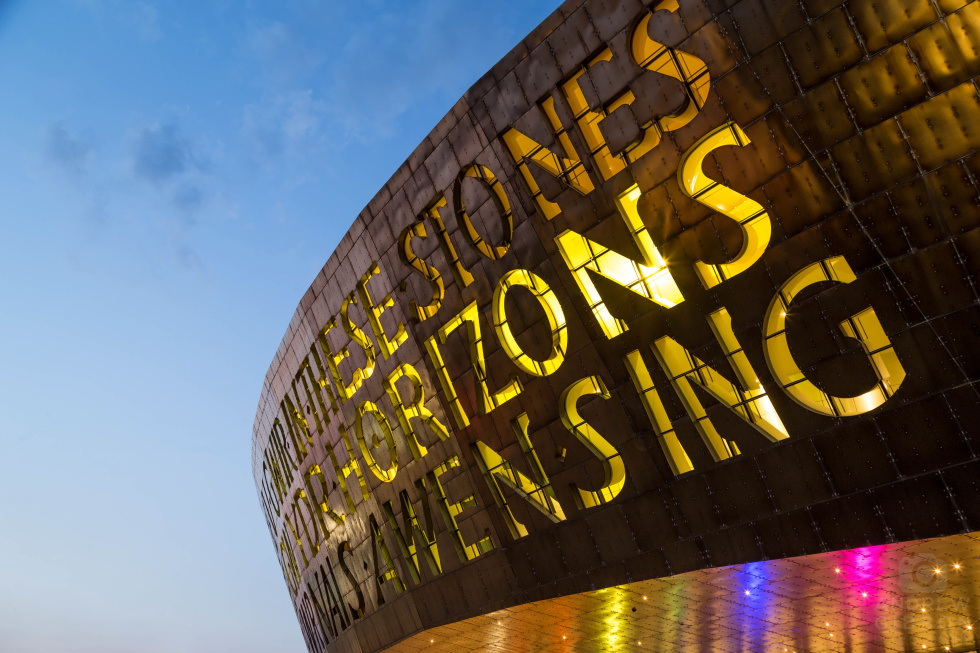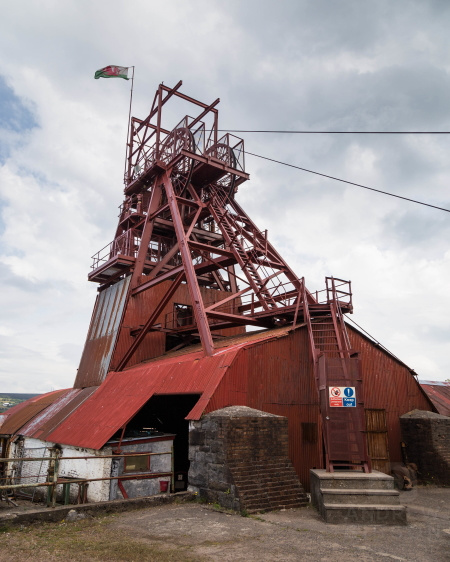It’s been a good few years since I was last in Cardiff – about 15 actually if you exclude a rainy November night in 2017 and even then I was only there for a gig. The same reason for this trip actually: Blondie were in town, and this year I decided to make a bit more of a thing of it.
I’d forgotten how much I liked Cardiff, as I arrived in the sweltering heat that had gripped the UK for the last five or six weeks and drove round the docks towards Grangetown, my base for the next few days. The docks themselves were busy with people on each evening I wandered down there, but not too busy to be uncomfortable. I had a few shots in mind and ended up coming away with various incarnations of the same ones, but this is the Wales Millennium Centre, it’s riveted steel roof intended to put one in mind of the steel industry that the area was once known for.
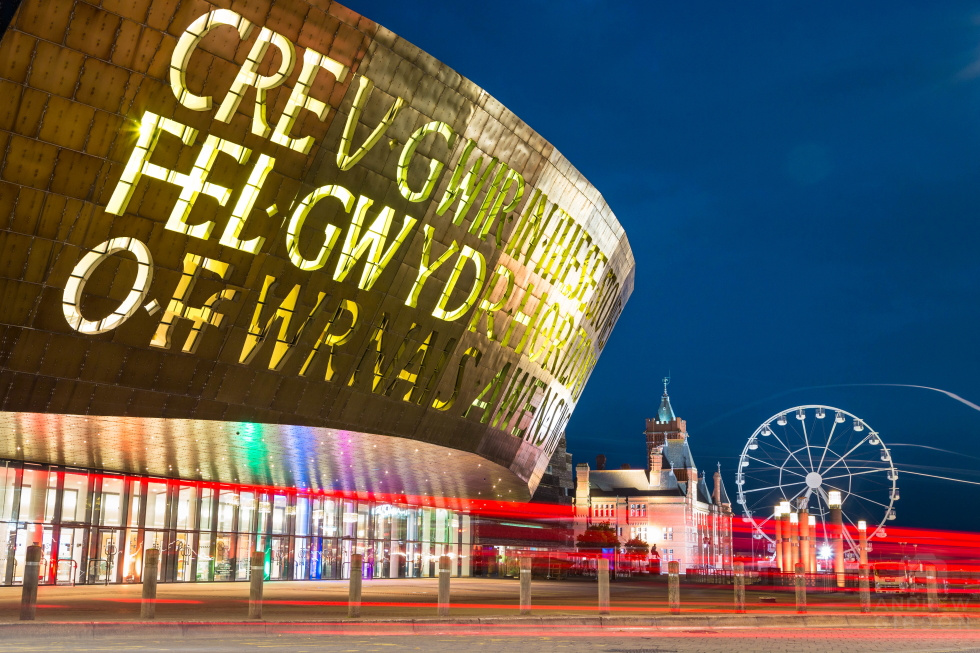
In actual fact Wales still does have a sizeable steel industry, with over 7000 steelworkers producing over half of the UK’s output in 2021, making it Wales’ fourth biggest export – not that you would necessarily notice it: in post-industrial Britain it always seems to be an endangered operation imminently liable to collapse and follow the rest of the heavy industry and coal mining in to the history books. You can only hope this landmark roof gives people food for thought.
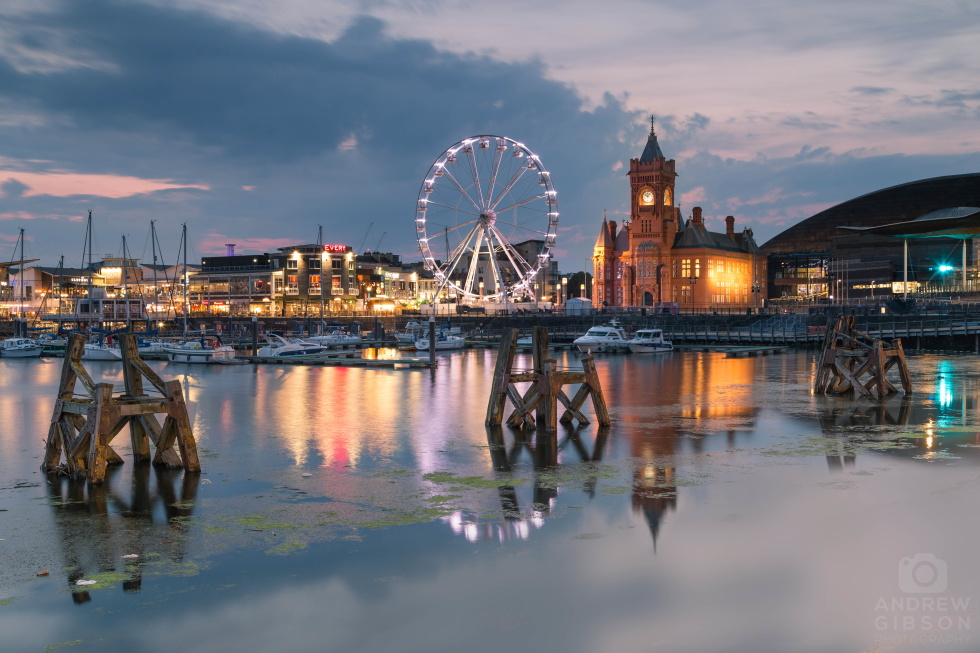
It feels quite celebratory round here: the lights on Mermaid Quay, the Ferris Wheel, the people milling about in the heat of the dusk, but still it’s not too busy. Maybe everyone was out in the city centre – it was certainly thriving with people overindulging to excess on the Friday night as I walked up to see the band at the Castle, but I avoided it otherwise as I would anywhere else under those circumstances.
The Grade I listed terracotta faced Pierhead Building makes a nice statement of the city’s heritage, erected in 1896 for the Bute Dock Company, though the East and West Bute Docks that flanked it have now largely vanished, filled in and redeveloped as the Senedd, various public amenities and piazzas, and the dual carriageway that bears wartime Prime Minister David Lloyd George’s name. Only the north end of the East Dock remains, now flanked by apartment blocks rather than coal staithes as is often the way.
On the waterfront, the Merchant Seafarer’s Memorial recognises the large numbers of men from the area that served – and gave their lives – to the country during past conflicts. A further nod to disappearing engineering practices, it fuses an anguished face with the hull of a ship in a way that’s both poignant and effective. At dusk you’d be forgiven for not noticing it as it’s certainly not illuminated, but it does work well when photographed with a creative long-exposure, the Pierhead Building in the background. I took this at a deliberate low angle to make it look bigger than it is in reality, cursing the swathes of largely unnecessary heras fencing that seemed to be lining the perfectly adequate railings in such a way that can only ever detract from the natural beauty of the scene…
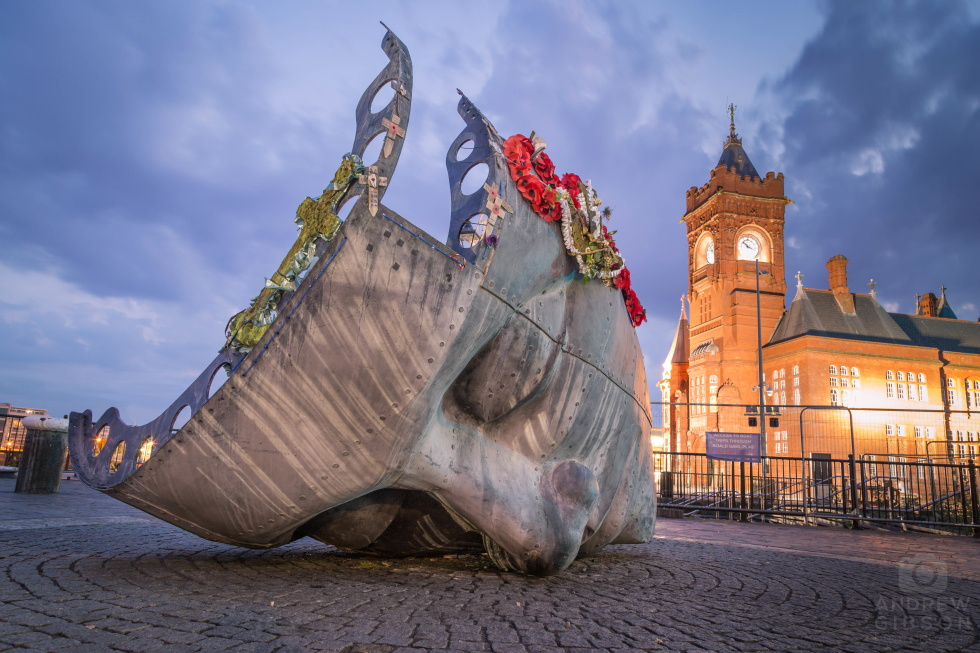
For an afternoon out I decided on a drive over the Severn Crossing in to England. Bristol isn’t somewhere I’ve spent much time before but since I was reasonably local I decided to pay a visit, and on a hot summer’s day if you can find occasional respite from the heat it’s all very pleasant. It’s also much bigger than I thought it was and despite marking up a few things I wanted to see I ended up spending the whole afternoon around Spike Island by the riverside rather than in the city itself. It was all very lively with dragon boat races on the feeder canal, although the sun mostly stayed hidden as soon as I was actually ready to get the camera out. I did manage a couple of shots of the area though when the light shone – this one of the marina just wouldn’t have worked without the sun making the coloured houses pop and casting reflections in the water:
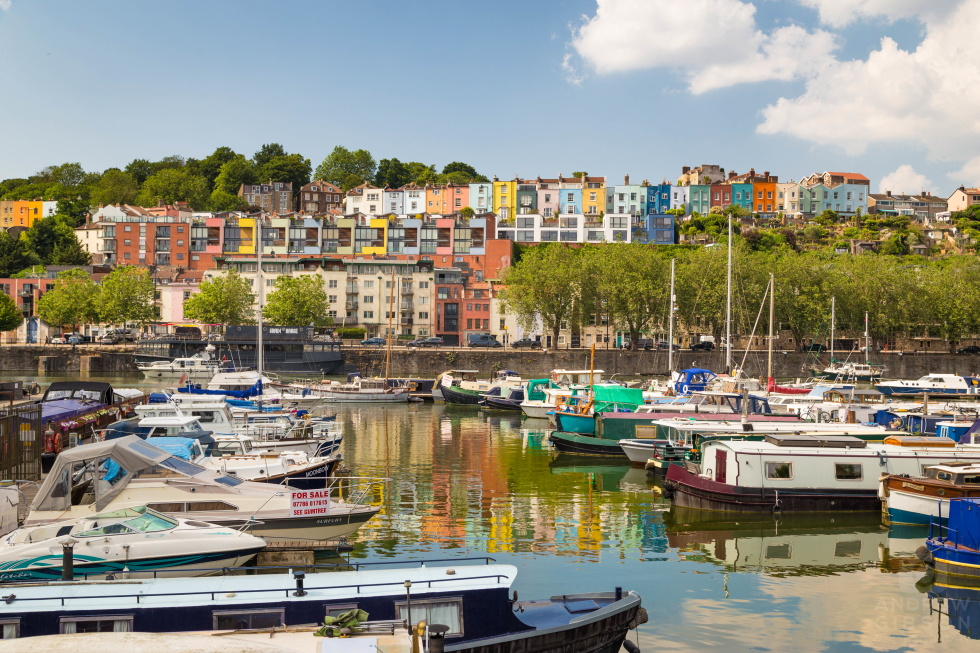
The light was fleeting but the heat relentless, as I walked along the waterfront towards something piercing the skyline… Bristol’s dock cranes came out of the Bath engineering firm Stothert & Pitt, specialists in such things but one which no longer manufactures anything. The run of four – numbers 29-32 – date back to 1951 when they replaced earlier models during the era of industrial modernisation, and were listed just last November in recognition of their now relative rarity, and importance here in the context of Princes Wharf. The electric giants remain in working order, and you can apparently even rent one as a guest house and stay in it…

I enjoyed an ice cream at the M Shed before heading over the Prince of Wales Bridge and back in to Wales. Back in the valleys I was in my element, revisiting a couple of old haunts on a day that kept threatening – but never quite succeeding – to break the dry spell of the last five or six weeks. I’m no stranger to the Welsh mining museum at Big Pit in Blaenafon, once again taking the underground tour, and I would still recommend anyone else to do the same. Aside from the ubiquitous stealth car parking charge it’s free, and you get an engaging hour on the group tour with a personable ex-miner to show you round and regale you with tales of their own – in this case tales of nearby Six Bells Colliery, of which there is no trace remaining, but there is a giant iron man statue commemorating those lost in pit disasters including their own. I covered that last time I was here and you can see more in my article on the South Wales Coalfield from November 2017.
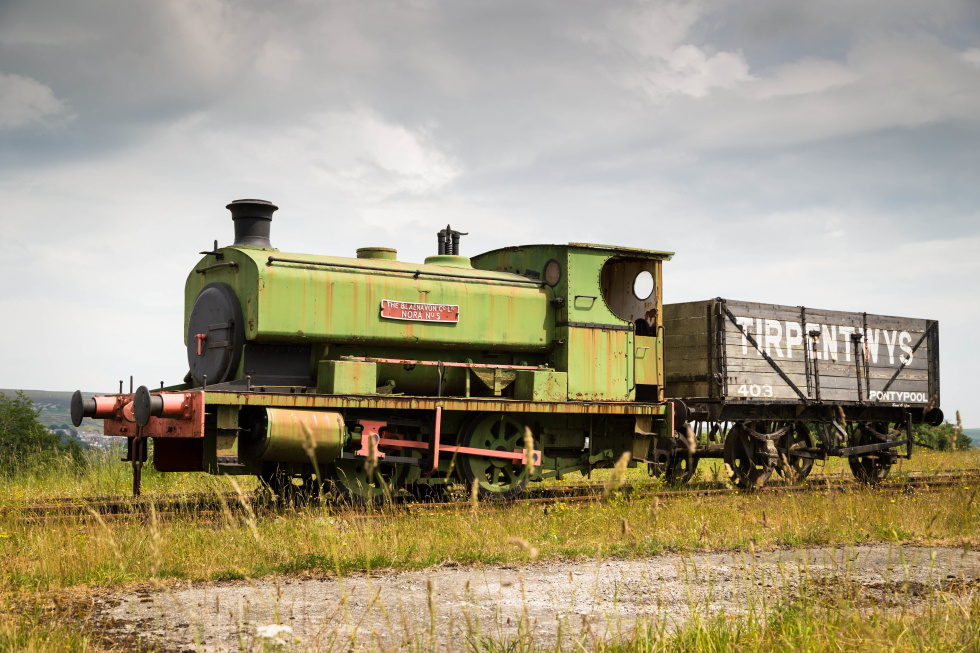
One interesting thing about places like Big Pit is the threat that nature poses in ending the whole operation. A pump failure or flash flood could submerge the workings and force its abandonment – it doesn’t make any significant kind of money and just wouldn’t be economically viable to save it in those circumstances.
Elsewhere across the country you’ll find others in various states of abandonment whose underground workings were flooded as part of the closure process decades ago. Penallta Colliery is one such place, somewhere I last visited in 2016, and this time I really only came to take a look at how much had changed and fly my drone around it for a different angle. Sadly my drone had gotten into an argument with a mob of irate pigeons over a derelict foundry in Rotherham the weekend before and now resides in the bottom of the River Don, and given that it was the third Mavic Mini I had lost or crashed I haven’t replaced it. A shame, given that I didn’t see a single bird in the vicinity of Penallta’s twin headframes as I noted that virtually nothing had changed in six and a half years since my friend and I were climbing about in the towering bath house and exploring the site from within…
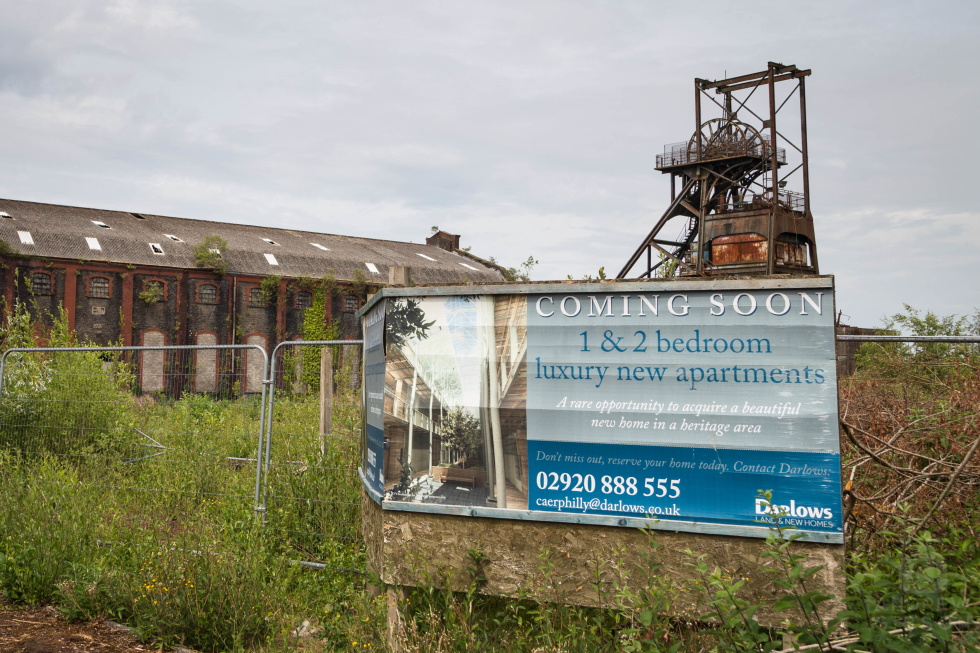
The same bath house now has some new build houses adjacent, and one of the ancillary buildings on Winding Wheel Lane that was roofless is now almost somebody’s home, but that aside the much vaunted power house conversion has gone nowhere and the head frames continue to sit in a twilight zone for which there appears to be no immediate plans.
This image of the upcast headgear and power house building with the warped and faded ‘luxury new apartments’ signage puts me in mind of Life on Mars or Back to the Future, and carries a kind of second-level dystopia all of its own.
During storms earlier this year the winding wheels began to turn in the high winds, a remarkable and ghostly sight that you can find with a quick Google search. Sadly it’s been the only movement on the site for quite some time.

I’m not really sure what to make of the plans for what’s left of this once record-breaking, most prolific part of the South Wales Coalfield, if they ever come to fruition, but who wouldn’t want this kind of heritage statement as the view from their house? It may be the past, but it was an almighty important part of the past. This is the identity of the valleys – and there’s not that much of it left.
I enjoyed being back in South Wales after so long, basking in the heat, eating fish and chips on Barry Island or an ice cream on Penarth Pier, relaxing by the docks of Cardiff or Bristol, catching a band at the castle and indulging my architectural and heritage interests. The day after I made it all the way back home to Lancashire just in time for the weather to finally break and give the land some much needed rain, as I watched from the windows and finally just sat down and relaxed…
Thanks for reading – see you next time.
